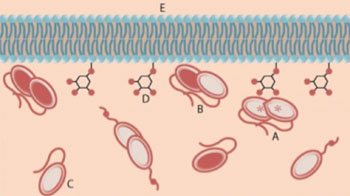PTEN Requires a Stable Dimer Configuration to Effectively Suppress Tumor Growth
|
By LabMedica International staff writers Posted on 01 Sep 2015 |

Image: An activated PTEN dimer that contains two non-mutant proteins (A) can transform the functional lipid (D) on the cellular membrane (E) into a chemical form that tunes down cancer predilection. Dimers that contain a mutated protein (B) or PTEN monomers cannot transform the functional lipid (Photo courtesy of Carnegie Mellon University).
Molecular structural analysis has shown that the PTEN (phosphatase and tensin homolog) tumor suppressor can function effectively only when two wild-type alleles are present to form a stable dimer that can act on lipids in the cell membrane.
PTEN, which is missing in 60% to 70% of metastatic cancers in humans, is the name of a phospholipid phosphatase protein, and gene that encodes it. The PTEN gene acts as a tumor suppressor gene thanks to the role of its protein product in regulation of the cycle of cell division, preventing cells from growing and dividing too rapidly.
Due to difficulties in crystallizing the PTEN dimer, investigators at Carnegie Mellon University (Pittsburgh, PA, USA) and a group of international collaborators used an advanced small-angle X-ray scattering (SAXS) technique to establish its structure in aqueous solution.
They reported in the August 20, 2015, online edition of the journal Structure that PTEN formed homodimers in vitro. To be fully functional, the C-terminal tails of the two proteins comprising the PTEN dimers had to bind the protein bodies in a cross-wise fashion, which made them more stable. As a result, they could more efficiently interact with the cell membrane, regulate cell growth, and suppress tumor formation.
Phosphorylation of the unstructured C-terminal tail of PTEN reduced PTEN activity, and this result was interpreted as a blockage of the PTEN membrane binding interface through this tail. The results presented in this paper instead suggested that the C-terminal tail functioned in stabilizing the homodimer, and that tail phosphorylation interfered with this stabilization.
"Membrane-incorporated and membrane-associated proteins like PTEN make up one-third of all proteins in our body. Many important functions in health and disease depend on their proper functioning," said senior author Dr. Mathias Lösche, professor of physics and of biomedical engineering at Carnegie Mellon University. "Despite PTEN's importance in human physiology and disease, there is a critical lack of understanding of the complex mechanisms that govern its activity."
Related Links:
Carnegie Mellon University
PTEN, which is missing in 60% to 70% of metastatic cancers in humans, is the name of a phospholipid phosphatase protein, and gene that encodes it. The PTEN gene acts as a tumor suppressor gene thanks to the role of its protein product in regulation of the cycle of cell division, preventing cells from growing and dividing too rapidly.
Due to difficulties in crystallizing the PTEN dimer, investigators at Carnegie Mellon University (Pittsburgh, PA, USA) and a group of international collaborators used an advanced small-angle X-ray scattering (SAXS) technique to establish its structure in aqueous solution.
They reported in the August 20, 2015, online edition of the journal Structure that PTEN formed homodimers in vitro. To be fully functional, the C-terminal tails of the two proteins comprising the PTEN dimers had to bind the protein bodies in a cross-wise fashion, which made them more stable. As a result, they could more efficiently interact with the cell membrane, regulate cell growth, and suppress tumor formation.
Phosphorylation of the unstructured C-terminal tail of PTEN reduced PTEN activity, and this result was interpreted as a blockage of the PTEN membrane binding interface through this tail. The results presented in this paper instead suggested that the C-terminal tail functioned in stabilizing the homodimer, and that tail phosphorylation interfered with this stabilization.
"Membrane-incorporated and membrane-associated proteins like PTEN make up one-third of all proteins in our body. Many important functions in health and disease depend on their proper functioning," said senior author Dr. Mathias Lösche, professor of physics and of biomedical engineering at Carnegie Mellon University. "Despite PTEN's importance in human physiology and disease, there is a critical lack of understanding of the complex mechanisms that govern its activity."
Related Links:
Carnegie Mellon University
Latest BioResearch News
- Genome Analysis Predicts Likelihood of Neurodisability in Oxygen-Deprived Newborns
- Gene Panel Predicts Disease Progession for Patients with B-cell Lymphoma
- New Method Simplifies Preparation of Tumor Genomic DNA Libraries
- New Tool Developed for Diagnosis of Chronic HBV Infection
- Panel of Genetic Loci Accurately Predicts Risk of Developing Gout
- Disrupted TGFB Signaling Linked to Increased Cancer-Related Bacteria
- Gene Fusion Protein Proposed as Prostate Cancer Biomarker
- NIV Test to Diagnose and Monitor Vascular Complications in Diabetes
- Semen Exosome MicroRNA Proves Biomarker for Prostate Cancer
- Genetic Loci Link Plasma Lipid Levels to CVD Risk
- Newly Identified Gene Network Aids in Early Diagnosis of Autism Spectrum Disorder
- Link Confirmed between Living in Poverty and Developing Diseases
- Genomic Study Identifies Kidney Disease Loci in Type I Diabetes Patients
- Liquid Biopsy More Effective for Analyzing Tumor Drug Resistance Mutations
- New Liquid Biopsy Assay Reveals Host-Pathogen Interactions
- Method Developed for Enriching Trophoblast Population in Samples
Channels
Clinical Chemistry
view channel
New Method Uses Pulsed Infrared Light to Find Cancer's 'Fingerprints' In Blood Plasma
Cancer diagnoses have traditionally relied on invasive or time-consuming procedures like tissue biopsies. Now, new research published in ACS Central Science introduces a method that utilizes pulsed infrared... Read more
Carbon Nanotubes Help Build Highly Accurate Sensors for Continuous Health Monitoring
Current sensors can measure various health indicators, such as blood glucose levels, in the body. However, there is a need to develop more accurate and sensitive sensor materials that can detect lower... Read moreMolecular Diagnostics
view channel
Rapid Blood Test Identifies Pre-Symptomatic Patients with Parkinson’s Disease
Currently, no reliable blood test exists for diagnosing Parkinson’s disease. Instead, physicians rely on observing a patient's movements, but this qualitative method has an error rate of 20%-25% and can... Read more
Blood Test for Early Alzheimer's Detection Achieves Over 90% Accuracy
Alzheimer's disease (AD) is a debilitating condition and a leading cause of disability and death worldwide. The availability of reliable diagnostic tools is currently restricted, and diagnosis often relies... Read more
RNA-Based Blood Test Detects Preeclampsia Risk Months Before Symptoms
Preeclampsia remains a major cause of maternal morbidity and mortality, as well as preterm births. Despite current guidelines that aim to identify pregnant women at increased risk of preeclampsia using... Read more
First Of Its Kind Test Uses microRNAs to Predict Toxicity from Cancer Therapy
Many men with early-stage prostate cancer receive stereotactic body radiotherapy (SBRT), a highly precise form of radiation treatment that is completed in just five sessions. Compared to traditional radiation,... Read moreHematology
view channel
New Scoring System Predicts Risk of Developing Cancer from Common Blood Disorder
Clonal cytopenia of undetermined significance (CCUS) is a blood disorder commonly found in older adults, characterized by mutations in blood cells and a low blood count, but without any obvious cause or... Read more
Non-Invasive Prenatal Test for Fetal RhD Status Demonstrates 100% Accuracy
In the United States, approximately 15% of pregnant individuals are RhD-negative. However, in about 40% of these cases, the fetus is also RhD-negative, making the administration of RhoGAM unnecessary.... Read moreImmunology
view channel
Stem Cell Test Predicts Treatment Outcome for Patients with Platinum-Resistant Ovarian Cancer
Epithelial ovarian cancer frequently responds to chemotherapy initially, but eventually, the tumor develops resistance to the therapy, leading to regrowth. This resistance is partially due to the activation... Read more
Machine Learning-Enabled Blood Test Predicts Immunotherapy Response in Lymphoma Patients
Chimeric antigen receptor (CAR) T-cell therapy has emerged as one of the most promising recent developments in the treatment of blood cancers. However, over half of non-Hodgkin lymphoma (NHL) patients... Read moreMicrobiology
view channel
Handheld Device Delivers Low-Cost TB Results in Less Than One Hour
Tuberculosis (TB) remains the deadliest infectious disease globally, affecting an estimated 10 million people annually. In 2021, about 4.2 million TB cases went undiagnosed or unreported, mainly due to... Read more
New AI-Based Method Improves Diagnosis of Drug-Resistant Infections
Drug-resistant infections, particularly those caused by deadly bacteria like tuberculosis and staphylococcus, are rapidly emerging as a global health emergency. These infections are more difficult to treat,... Read more
Breakthrough Diagnostic Technology Identifies Bacterial Infections with Almost 100% Accuracy within Three Hours
Rapid and precise identification of pathogenic microbes in patient samples is essential for the effective treatment of acute infectious diseases, such as sepsis. The fluorescence in situ hybridization... Read morePathology
view channel
"Metal Detector" Algorithm Hunts Down Vulnerable Tumors
Scientists have developed an algorithm capable of functioning as a "metal detector" to identify vulnerable tumors, marking a significant advancement in personalized cancer treatment. This breakthrough... Read more
Novel Technique Uses ‘Sugar’ Signatures to Identify and Classify Pancreatic Cancer Cell Subtypes
Pancreatic cancer is often asymptomatic in its early stages, making it difficult to detect until it has progressed. Consequently, only 15% of pancreatic cancers are diagnosed early enough to allow for... Read moreTechnology
view channel
Pain-On-A-Chip Microfluidic Device Determines Types of Chronic Pain from Blood Samples
Chronic pain is a widespread condition that remains difficult to manage, and existing clinical methods for its treatment rely largely on self-reporting, which can be subjective and especially problematic... Read more
Innovative, Label-Free Ratiometric Fluorosensor Enables More Sensitive Viral RNA Detection
Viruses present a major global health risk, as demonstrated by recent pandemics, making early detection and identification essential for preventing new outbreaks. While traditional detection methods are... Read moreIndustry
view channel
Cepheid and Oxford Nanopore Technologies Partner on Advancing Automated Sequencing-Based Solutions
Cepheid (Sunnyvale, CA, USA), a leading molecular diagnostics company, and Oxford Nanopore Technologies (Oxford, UK), the company behind a new generation of sequencing-based molecular analysis technologies,... Read more
Grifols and Tecan’s IBL Collaborate on Advanced Biomarker Panels
Grifols (Barcelona, Spain), one of the world’s leading producers of plasma-derived medicines and innovative diagnostic solutions, is expanding its offer in clinical diagnostics through a strategic partnership... Read more























